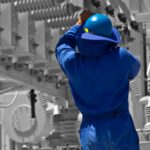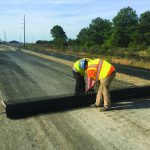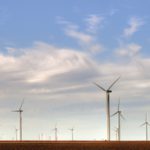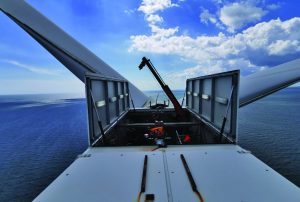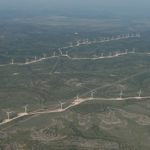Building-integrated wind turbines (BIWT) are becoming more prevalent in the landscape across the United States, as well as in Europe. There are many challenges with integrating wind turbines into existing buildings that are not entirely obvious, even upon thorough investigation of a proposed installation.
One of the most serious challenges is probably that the building itself is an obstruction in the flow, thus creating a completely different environment for harvesting wind energy than what is found in a typical open-space turbine installation site. For instance, in a conventional turbine installation in an open area there is generally a wind shear effect that causes the wind speed to increase with height as the flow gets farther away from the ground (i.e. a boundary layer over a no-slip condition). Thus, it is often assumed that placing a wind turbine on top of a building would help capture more wind energy, since “higher must be better.” As the building causes a disruption in the flow, however, the behavior of the wind in the vicinity is not directly comparable to the wind field in wide-open terrain.
There are two distinct differences that must be considered in a BIWT siting analysis: 1) a single location on a building will see very different wind speeds than the free stream upwind conditions, and 2) this variation is dependent on the direction from which the wind is blowing. So, while a wind turbine in a wide-open field will capture the free stream velocity of the wind equally from any direction, a wind turbine on a building is going to see quite altered wind speeds from the upstream values as the wind shifts direction. In fact, it is even possible that placing a turbine at some central location above a building could actually place it in a vortical dead spot during some periods. As there are very few rules of thumb for siting wind turbines on buildings, finding the optimal location is no simple task. Several research studies have been conducted in recent years addressing this issue, showing that the difference between poor siting and optimal siting on a building can mean an improvement factor of 1,000 in available power density.
Assuming a free stream estimated wind resource that merits further investigation, a general guideline one might consider today would be to place the turbines above a predicted wind shear layer over the building, as was done by ZGF Architects. Additionally, it is likely that coastal locations or sites with a consistent wind flow direction would see better performance than sites with more distributed prevalent wind directions—and thus more variability in performance for a specific site on a building. For urban areas, as with conventional installations, it is important to consider any upstream obstructions in the wind flow in addition to the obstructions caused by the building itself. In the end, an anemometer placed in the exact proposed location of the turbine is the best bet for a performance prediction. Fluid dynamic simulations can also be quite useful, but also expensive.
The next challenge is the structural integration of the device with the building. Depending on local requirements, a structural engineer may need to sign off on the tower and integration design. Building codes should be referenced, and safety issues should be addressed. This building integration can cost significantly more than one on the ground and should be considered in the economic analysis. Turbulence is also more severe in the built environment and may limit the selection of turbines that are designed to operate in this setting as well as cause unwanted structural vibrations and/or noise.
Aesthetics may also be more important for installations in the built environment. Personal experiences with architects have shown that vertical axis wind turbines (VAWTs) are more aesthetically pleasing to those in the field of building design. Many vertical axis machines are also marketed for this use. While VAWTs may or may not prove suitable for the built environment (a whole other discussion), any potential end user of a small wind turbine should be aware of the certifications of such devices. Currently in the U.S. few small wind turbines on the market have any level of third-party certification. I recommend checking the Small Wind Certification Council’s Web site at www.smallwindcertification.org/certified_turbines.html for the most up to date information on certified turbines.
As many challenges as there may be, projects will still move forward with motivations to be green or make a statement. New construction projects open to building orientation and augmentation opportunities will likely have more prospects for enhancing turbine performance than integrating turbines onto existing buildings. There are still many open areas of research needed to address cost effective structural integration, establish a better understanding of turbine performance in the highly turbulent conditions around a building, and develop rules of thumb for siting that can be applied more broadly.

















